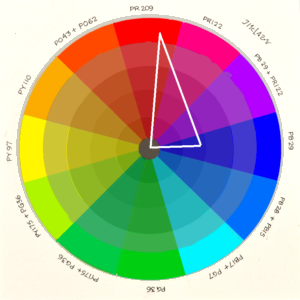Over the last several years, there has been an influx of new ‘neutral tints’ introduced by manufacturers of artist paints almost as though there has been a new pigment discovered. In a way there has. There are new (20thC) pigments that are more transparent, which means that a good, transparent neutral can be mixed. However, not all the Neutral Tints on the market are transparent.
Neutral tint formulations have been around since the 18th C developed by watercolor artists – and historically have been called ‘grays’. Neutral tints are sold as a paint that can be used to neutralize any other pigment (reduce the chromacity, or ‘tone down’) . The following is an excerpt from the description for Neutral Tint paint by Daniel Smith:
“Create Rich Darks and Neutrals with this fabulous and unique, dark neutral pigment that when mixed with any watercolor pigment produces glowing, darker values of that color. We wanted to make it easier for students to keep away from making muddy darks in one easy step, and this is the perfect solution! Features and Benefits: Quick and reliable way to darken a color while retaining transparency. Produces gorgeous glowing darks rather than muddy colors. Tones down colors.”
So why not just use black? Many watercolorists avoid black, and for some good reasons. Most classical blacks are made from carbon obtained from burning something – like lamp oil, bone (replaced Ivory), coal, etc. In other words, they are made from soot. Blacks made from soot produce a pigment that is very dull – this is because the carbon molecules tend to scatter light randomly more than other pigments. The ‘ideal’ black reflects no light at all. In watercolor, passages that contain carbon black pigments might appear gorgeous when wet, but become flat when dry. Therefore, adding a carbon black to tone down paint tends to dull it as well. So, how do we reduce the chroma of paint withOUT using black? Supposedly, that is the idea of ‘neutral tints’.
The ideal neutral tint will not change the hue of the paint you add it to, only the chroma. In addition it should not change the transparency and/or granulation qualities of the paint. The only neutral mix that can accomplish this is one that is transparent and non-granulating itself. This type of mix is much more attainable with modern 20th C pigments.
Traditionally, Neutral Tints have been called grays, and some of them are still available today under the originating artist’s name (like Payne’s Gray, or Davy’s Gray, etc). Originally, these formulas contained an earth red, a blue, and a touch of an earthy yellow – a primary triad. Most of the neutral tints today are made with a blue or violet mixed with a black. (We will look at some of the formulae in Part 3 of this blog.)
You might wonder “what is the distinction between a Neutral Tint and a Gray?” They have similar hues and chromas (ie: they are all ‘gray-like’). Neutral tints are more transparent – to be used to reduce the chroma of another paint, whereas the grays often have more ‘character’ – they may contain pigments that settle and granulate – so they are more useful as standalone paints.
The neutral that you want will often depend on how you are planning to use it. If you’re glazing you will want transparency. If you’re using it to get texture you will want one that has a good sinker in it – Ultramarine and iron oxides (earth yellows and reds) are about the only sinkers that are offered in the popular neutral and gray mixes. However, there are many more possibilities. If you want to mix your neutral with other paints – for example, to reduce the chroma – like for shadows, then you probably want something that will not muddy it. Mixes that contain too many different colors will tend to muddy. Beware of the neutrals that have 3 or more pigments in their mix. The fewer pigments in your neutral the less likely it is to create mud when you mix it with other paints.
[I will refer to ‘sinkers’ and ‘floaters’ many times throughout this blog. To learn more about these terms, see my Reference Sinkers and Floaters]
In the next post, we will discuss different ways to make a Neutral.
